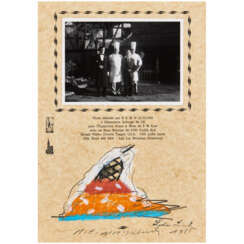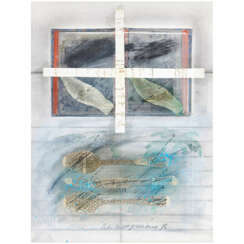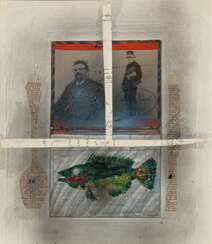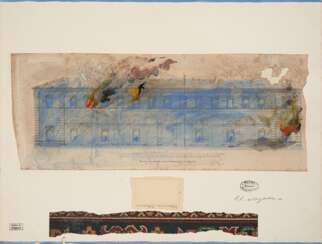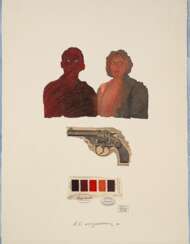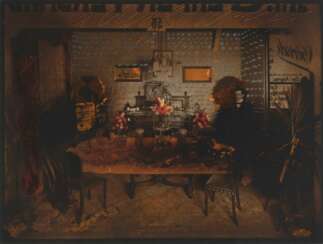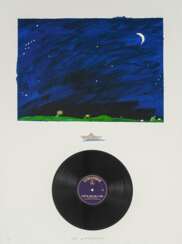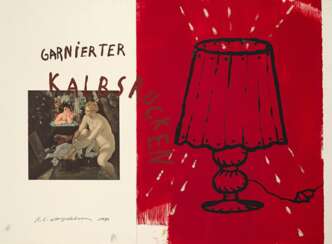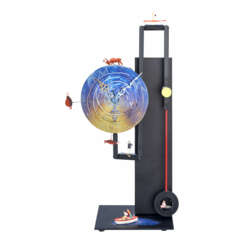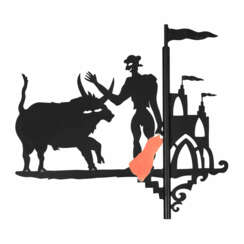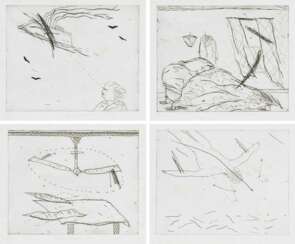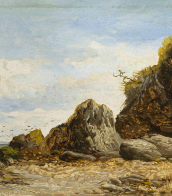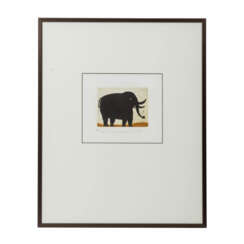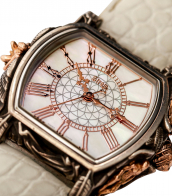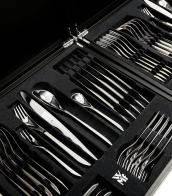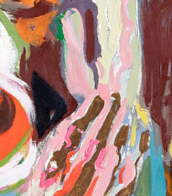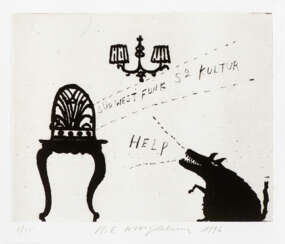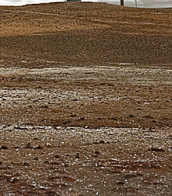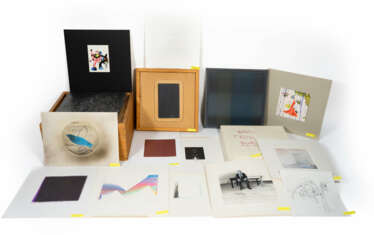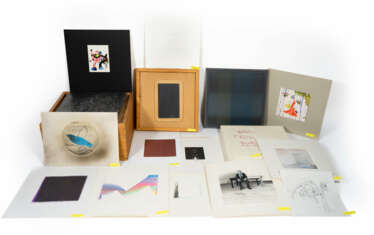raymond waydelich (1938)
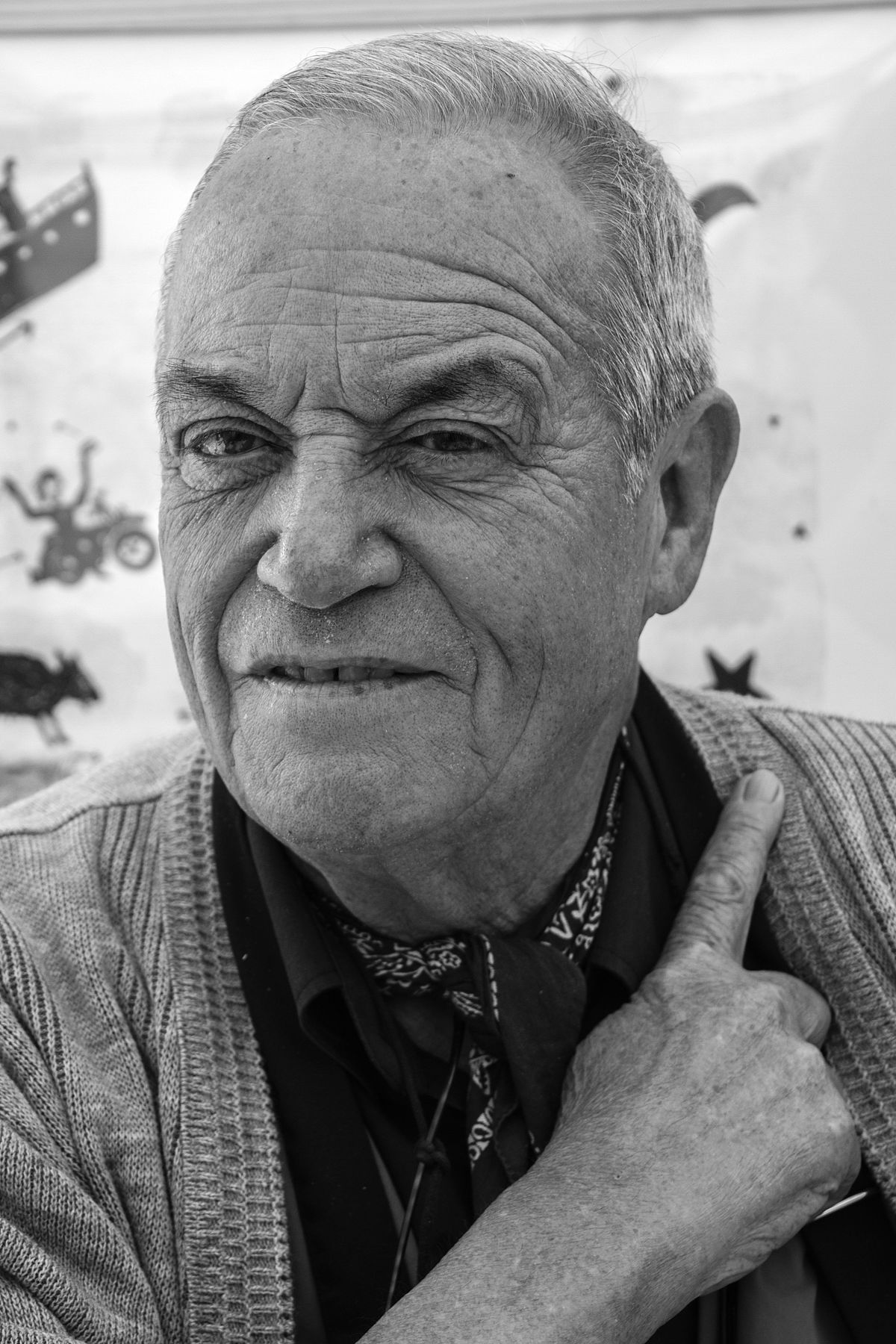
Raymond-Émile Waydelich is a French-Alsatian painter, sculptor and action artist. He lives and works in Hindisheim/Alsace.
Waydelich's extensive oeuvre includes paintings, sculptures and sculptures in ceramic or bronze, assemblages, works on paper as well as public art actions and performances. The artistic techniques of his colourful, playful, witty and whimsical graphics range from drawing, watercolour, lithography, etching and monotype to overpaintings of found paper objects.
He is one of France's best-known living artists. His works are in numerous public and private collections worldwide. His watercolour collages have become particularly famous, showing real-life creatures (crocodile, cat, pig) ghostly alienated within landscapes, which the artist painted on antique letters, some of which he acquired on journeys (e.g. to Crete). His style, which often takes up perspectives, motifs and elements of prehistoric cave paintings or Greek mythology, approaches fantastic realism.
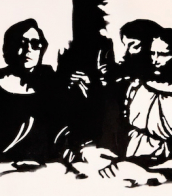

Raymond-Émile Waydelich is a French-Alsatian painter, sculptor and action artist. He lives and works in Hindisheim/Alsace.
Waydelich's extensive oeuvre includes paintings, sculptures and sculptures in ceramic or bronze, assemblages, works on paper as well as public art actions and performances. The artistic techniques of his colourful, playful, witty and whimsical graphics range from drawing, watercolour, lithography, etching and monotype to overpaintings of found paper objects.
He is one of France's best-known living artists. His works are in numerous public and private collections worldwide. His watercolour collages have become particularly famous, showing real-life creatures (crocodile, cat, pig) ghostly alienated within landscapes, which the artist painted on antique letters, some of which he acquired on journeys (e.g. to Crete). His style, which often takes up perspectives, motifs and elements of prehistoric cave paintings or Greek mythology, approaches fantastic realism.


Raymond-Émile Waydelich is a French-Alsatian painter, sculptor and action artist. He lives and works in Hindisheim/Alsace.
Waydelich's extensive oeuvre includes paintings, sculptures and sculptures in ceramic or bronze, assemblages, works on paper as well as public art actions and performances. The artistic techniques of his colourful, playful, witty and whimsical graphics range from drawing, watercolour, lithography, etching and monotype to overpaintings of found paper objects.
He is one of France's best-known living artists. His works are in numerous public and private collections worldwide. His watercolour collages have become particularly famous, showing real-life creatures (crocodile, cat, pig) ghostly alienated within landscapes, which the artist painted on antique letters, some of which he acquired on journeys (e.g. to Crete). His style, which often takes up perspectives, motifs and elements of prehistoric cave paintings or Greek mythology, approaches fantastic realism.
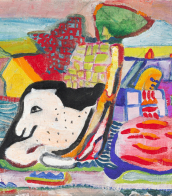

Raymond-Émile Waydelich is a French-Alsatian painter, sculptor and action artist. He lives and works in Hindisheim/Alsace.
Waydelich's extensive oeuvre includes paintings, sculptures and sculptures in ceramic or bronze, assemblages, works on paper as well as public art actions and performances. The artistic techniques of his colourful, playful, witty and whimsical graphics range from drawing, watercolour, lithography, etching and monotype to overpaintings of found paper objects.
He is one of France's best-known living artists. His works are in numerous public and private collections worldwide. His watercolour collages have become particularly famous, showing real-life creatures (crocodile, cat, pig) ghostly alienated within landscapes, which the artist painted on antique letters, some of which he acquired on journeys (e.g. to Crete). His style, which often takes up perspectives, motifs and elements of prehistoric cave paintings or Greek mythology, approaches fantastic realism.


Raymond-Émile Waydelich is a French-Alsatian painter, sculptor and action artist. He lives and works in Hindisheim/Alsace.
Waydelich's extensive oeuvre includes paintings, sculptures and sculptures in ceramic or bronze, assemblages, works on paper as well as public art actions and performances. The artistic techniques of his colourful, playful, witty and whimsical graphics range from drawing, watercolour, lithography, etching and monotype to overpaintings of found paper objects.
He is one of France's best-known living artists. His works are in numerous public and private collections worldwide. His watercolour collages have become particularly famous, showing real-life creatures (crocodile, cat, pig) ghostly alienated within landscapes, which the artist painted on antique letters, some of which he acquired on journeys (e.g. to Crete). His style, which often takes up perspectives, motifs and elements of prehistoric cave paintings or Greek mythology, approaches fantastic realism.


Raymond-Émile Waydelich is a French-Alsatian painter, sculptor and action artist. He lives and works in Hindisheim/Alsace.
Waydelich's extensive oeuvre includes paintings, sculptures and sculptures in ceramic or bronze, assemblages, works on paper as well as public art actions and performances. The artistic techniques of his colourful, playful, witty and whimsical graphics range from drawing, watercolour, lithography, etching and monotype to overpaintings of found paper objects.
He is one of France's best-known living artists. His works are in numerous public and private collections worldwide. His watercolour collages have become particularly famous, showing real-life creatures (crocodile, cat, pig) ghostly alienated within landscapes, which the artist painted on antique letters, some of which he acquired on journeys (e.g. to Crete). His style, which often takes up perspectives, motifs and elements of prehistoric cave paintings or Greek mythology, approaches fantastic realism.


Raymond-Émile Waydelich is a French-Alsatian painter, sculptor and action artist. He lives and works in Hindisheim/Alsace.
Waydelich's extensive oeuvre includes paintings, sculptures and sculptures in ceramic or bronze, assemblages, works on paper as well as public art actions and performances. The artistic techniques of his colourful, playful, witty and whimsical graphics range from drawing, watercolour, lithography, etching and monotype to overpaintings of found paper objects.
He is one of France's best-known living artists. His works are in numerous public and private collections worldwide. His watercolour collages have become particularly famous, showing real-life creatures (crocodile, cat, pig) ghostly alienated within landscapes, which the artist painted on antique letters, some of which he acquired on journeys (e.g. to Crete). His style, which often takes up perspectives, motifs and elements of prehistoric cave paintings or Greek mythology, approaches fantastic realism.


Raymond-Émile Waydelich is a French-Alsatian painter, sculptor and action artist. He lives and works in Hindisheim/Alsace.
Waydelich's extensive oeuvre includes paintings, sculptures and sculptures in ceramic or bronze, assemblages, works on paper as well as public art actions and performances. The artistic techniques of his colourful, playful, witty and whimsical graphics range from drawing, watercolour, lithography, etching and monotype to overpaintings of found paper objects.
He is one of France's best-known living artists. His works are in numerous public and private collections worldwide. His watercolour collages have become particularly famous, showing real-life creatures (crocodile, cat, pig) ghostly alienated within landscapes, which the artist painted on antique letters, some of which he acquired on journeys (e.g. to Crete). His style, which often takes up perspectives, motifs and elements of prehistoric cave paintings or Greek mythology, approaches fantastic realism.


Raymond-Émile Waydelich is a French-Alsatian painter, sculptor and action artist. He lives and works in Hindisheim/Alsace.
Waydelich's extensive oeuvre includes paintings, sculptures and sculptures in ceramic or bronze, assemblages, works on paper as well as public art actions and performances. The artistic techniques of his colourful, playful, witty and whimsical graphics range from drawing, watercolour, lithography, etching and monotype to overpaintings of found paper objects.
He is one of France's best-known living artists. His works are in numerous public and private collections worldwide. His watercolour collages have become particularly famous, showing real-life creatures (crocodile, cat, pig) ghostly alienated within landscapes, which the artist painted on antique letters, some of which he acquired on journeys (e.g. to Crete). His style, which often takes up perspectives, motifs and elements of prehistoric cave paintings or Greek mythology, approaches fantastic realism.


Raymond-Émile Waydelich is a French-Alsatian painter, sculptor and action artist. He lives and works in Hindisheim/Alsace.
Waydelich's extensive oeuvre includes paintings, sculptures and sculptures in ceramic or bronze, assemblages, works on paper as well as public art actions and performances. The artistic techniques of his colourful, playful, witty and whimsical graphics range from drawing, watercolour, lithography, etching and monotype to overpaintings of found paper objects.
He is one of France's best-known living artists. His works are in numerous public and private collections worldwide. His watercolour collages have become particularly famous, showing real-life creatures (crocodile, cat, pig) ghostly alienated within landscapes, which the artist painted on antique letters, some of which he acquired on journeys (e.g. to Crete). His style, which often takes up perspectives, motifs and elements of prehistoric cave paintings or Greek mythology, approaches fantastic realism.

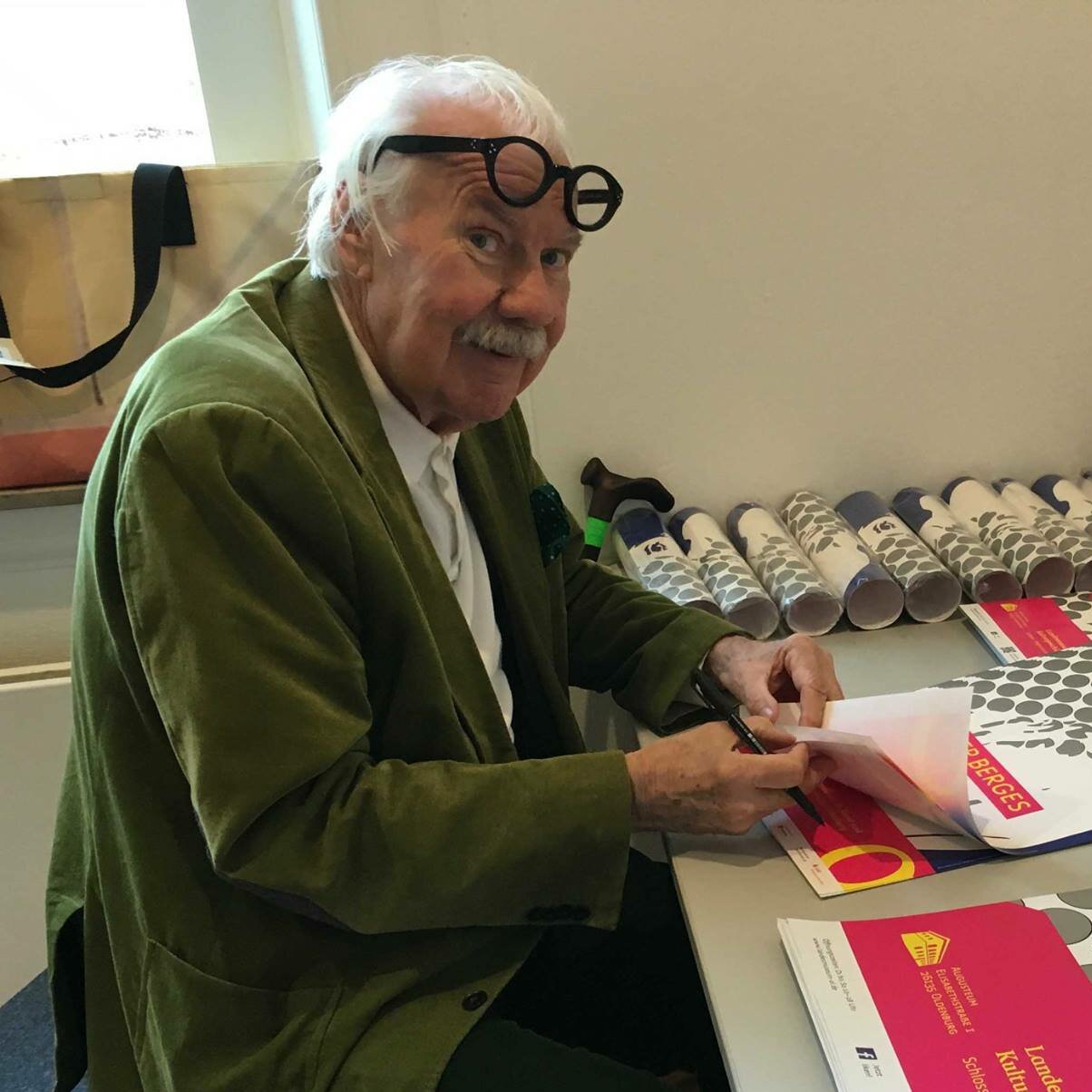
Werner Berges is a contemporary German artist and graphic artist, a representative of Pop Art.
Typical of him are bright colours and sharp outlines, the use of spot painting and the strips that give his works the character of reproductions. The heroes of his paintings are pop and film stars, advertising types of women and photo-models, whose erotic poses and captivating glances Werner Berges emphasizes with a powerful combination of colours, points, stripes and collage. At the core of his drawing is a "graphic framework" that exists independently of the overlay of colours on the canvas. The artist tries to show himself to be completely independent and impartial about what he has created and only signs his work on the back of the canvas.

